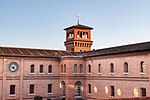Port of Ripa Grande and Papal Arsenal
Rome R. XIII TrastevereTransport in Rome

Porto di Ripa Grande was the river port of Rome, just downstream the former Pons Sublicius, where the wares, going up and down the Tiber towards the dock of Fiumicino, were handled. The building of the muraglioni (massive walls) has erased its existence and function, just keeping a trace in the toponymy (the stretch of Lungotevere, that flanks San Michele a Ripa Grande, is called Porto di Ripa Grande, while Via del Porto is the narrow street that links the Tiber to Santa Cecilia in Trastevere and Santa Maria dell'Orto) and in the two ramps giving access to the quay of the river.
Excerpt from the Wikipedia article Port of Ripa Grande and Papal Arsenal (License: CC BY-SA 3.0, Authors, Images).Port of Ripa Grande and Papal Arsenal
Pista ciclabile del Tevere, Rome Municipio Roma I
Geographical coordinates (GPS) Address Nearby Places Show on map
Geographical coordinates (GPS)
| Latitude | Longitude |
|---|---|
| N 41.8844 ° | E 12.4766 ° |
Address
Pista ciclabile del Tevere
Pista ciclabile del Tevere
00153 Rome, Municipio Roma I
Lazio, Italy
Open on Google Maps









